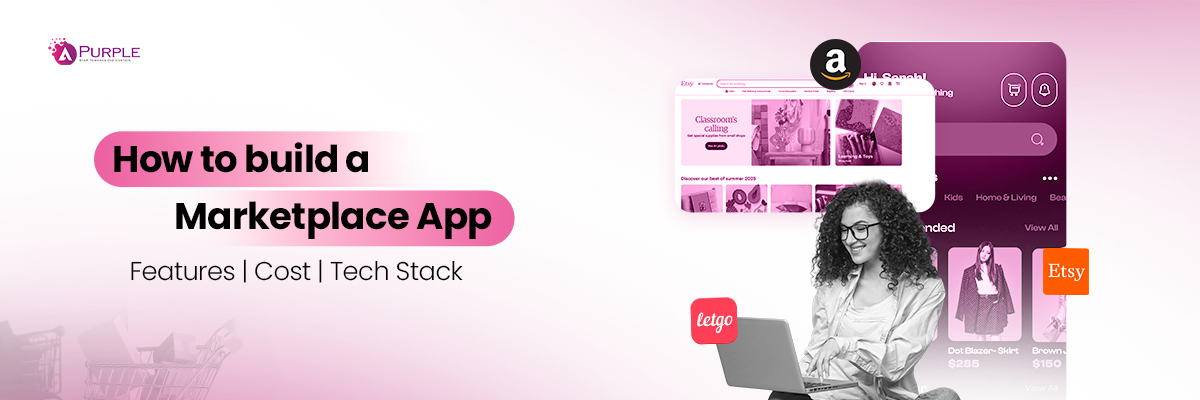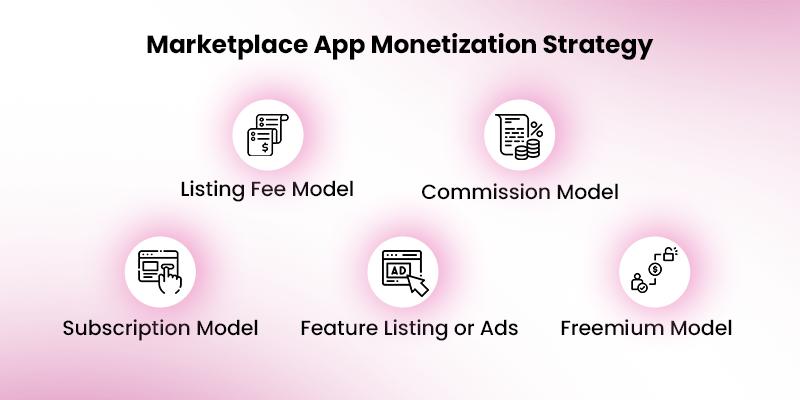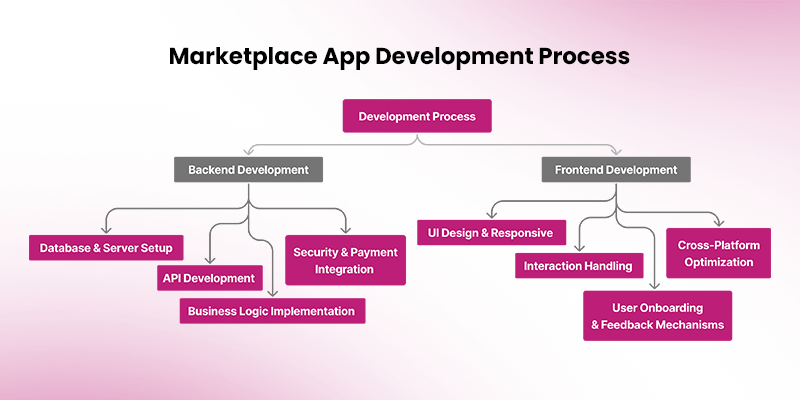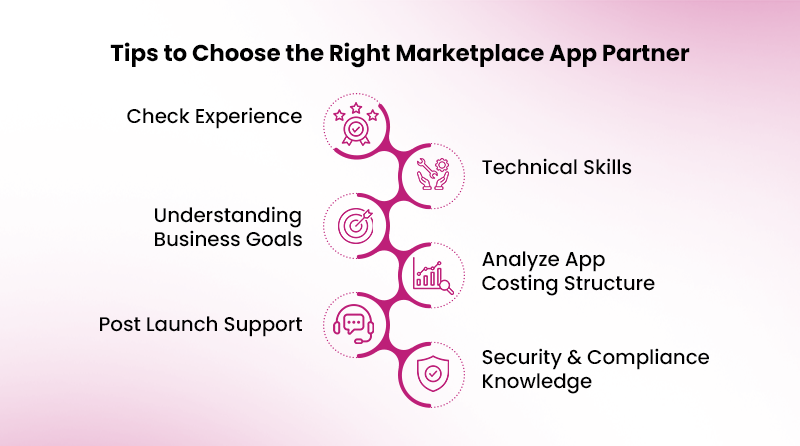
What makes online marketplaces platforms like Amazon, eBay, Etsy, Airbnb, or other similar companies so widely adopted across audiences of different demographics?
The secret lies in building the right kind of marketplace app that connects buyers and sellers seamlessly, scales easily, and stands out at a time when we’re flooded with a horde of similar apps. Whether you’re thinking of launching a B2B platform, a service marketplace, or an NFT marketplace, choosing the right development strategy, knowing how much it’ll cost you, what features to consider, and which challenges you’re likely to encounter is crucial.
It’s also important to understand the costs involved, key features required, and common challenges you might face along the way. Partnering with an experienced ecommerce app development company can bring this vision to life with the right technology and roadmap.
This guide will help you plan every phase of your marketplace app development journey, from understanding your target audience and defining your app’s core features to selecting the best tech stack and exploring various revenue models. We’ll also share expert tips for tackling real-world challenges, whether you’re building a multivendor platform or a niche-focused marketplace.
What is Marketplace App Development and How Does it Work?
Marketplace app development is building a mobile or web platform that connects buyers and sellers, or service providers and users, in one place. You can understand this as a digital middleman that manages listing, transactions, payments, and user communication.
Unlike a single-vendor ecommerce platform, a multivendor marketplace app development solution allows multiple businesses to offer products or services through a shared platform.
How does a Marketplace App Work?
Below is the simplified flow of how a marketplace app functions:
- Sellers sign up and upload products or services with all necessary details.
- Buyers register, search, filter, add items to the cart, and check out.
- Payments are often handled via escrow to build trust.
- Delivery or service happens off-platform or via vendor fulfillment.
- Rating systems help maintain quality.
- The platform earns revenue via different methods, like ads or service fees.
This model is often used across different industries, including e-commerce, freelancing, real estate, travel, and even NFT marketplace app development.
Do you know? The global eCommerce market is predicted to increase from USD 551 billion in 2025 to approximately USD 2,000 billion by 2034, expanding at a CAGR of approximately 16% from 2025 to 2034. At the same time, mobile commerce is increasing rapidly, expected to make up around 59% of total ecommerce by 2025.
How to Create a Marketplace App?
If you’re looking to create a marketplace app, we’ve outlined the essential phases below. Let’s discuss each phase in detail and explore how to implement them in the development of an online marketplace app.
1. Define your Marketplace Type
The first step is to pick the type of marketplace app you want to build for your business, according to your target audience. Specify your need and categorize the right marketplace platforms to target your audience and build an app that understands your customers’ needs.
Given below is the table, which will help you in understanding the different types of marketplace apps available:
| Different Types of Marketplace Apps | ||
|---|---|---|
| Type | Features | Popular Business Apps |
| Business-to-Business (B2B) | B2B is a type of marketplace app that connects one business with another. These apps are typically used for purchasing and selling wholesale products, services, or equipment. |
|
| Business-to-Customer (B2C) | Another type is the B2C marketplace apps, which connect businesses with consumers and are typically used for buying and selling retail products or services. |
|
| Peer-to-Peer | Peer-to-peer marketplace apps connect consumers with other consumers. These apps are mostly used for buying and selling used goods or services. |
|
| Vertical | With a vertical marketplace mobile application, customers can connect with specialists to perform everyday tasks associated with cleaning, home repairs, office administration, traveling, etc. |
|
| Horizontal | These are online platforms or applications that facilitate transactions and interactions across a wide range of products, services, or categories, without specializing in a specific niche. |
|
2. Plan your Marketplace Application
Once you have selected the type, now it’s time to plan your app comprehensively. Here is what to focus on:
| Key Aspects | What to do |
|---|---|
| Define the niche | Choose the industry or category of your marketplace app, such as eCommerce, rentals, delivery, or freelance. |
| Know your Audience | Define your target audience, understand their needs, behavior & plan to design your marketplace application accordingly. |
| Research Competitors | Look into similar marketplace apps in your category to identify what works and what doesn’t. |
| Decide on Key Features | The final step is to incorporate essential features like user profiles, listings, filters, payments, and reviews to make your online marketplace application stand out in the market. |
This planning app is the backbone of your marketplace app development. Skipping this step will lead to weak app positioning.
3. Select a Monetization Strategy
The third step is to select the right monetization model, which is the key to long-term success. Below are some proven strategies that you can follow:
1. Listing Fee Model
Another model is the listing fee model, where sellers are charged a fee for listing their products or services on the marketplace app. This method ensures you earn revenue even if the product doesn’t sell immediately.
2. Commission Model
Among all the models, this is one of the most widely used. Under this model, a commission fee is charged on each successful transaction between the buyers and the sellers on the platform.
3. Subscription Model
Another monetization model is the subscription model, in which users or sellers pay a recurring fee (monthly or annually) to unlock the premium features. This is ideal for the platforms that provide ongoing value, such as networking or learning.
4. Feature Listing or Ads
Under this, sellers can pay to highlight their listings, which helps them gain more visibility. This model is great for generating extra revenue while helping sellers stand out from their competitors.
5. Freemium Model
In this type of type of business model, the users get access to basic services for free but can pay to unlock advanced tools and features. This model works well if your app offers tiered services or content.
4. Reach Out to a Marketplace App Development Company
This is the most important step in the entire process: collaborating with a professional marketplace app development company. Look for a team that:
- Understands your project goals clearly
- Have experience in multi-vendor marketplace app development
- Offer full-cycle development- from idea to deployment
- Can provide a dedicated marketplace app development team
It is important to keep in mind that collaborating with a reputable marketplace app – startup consulting services ensures faster delivery and better quality.
5. Design the UI/UX for the Marketplace App
Your application’s user experience matters a lot, especially in service marketplace app development. Great design leads to better engagement and higher retention.
Here’s what typically happens:
- Wireframes are created to show how the app will look
- Prototypes are built for user flows
- UI/UX design adds branding and smooth interactions
Keep the design intuitive and minimal. Focus on how users search, browse, buy, and communicate on the app.
6. Start the Development Phase
After the design is approved, development begins. This stage includes both frontend and backend coding.
Marketplace mobile app development often uses technologies like React Native, Node.js, AWS, and Firebase to ensure scalability and performance.
According to Forbes, launching an MVP allows startups to test their ideas in real market conditions with minimal risk and cost, making it a smart move before committing to full development.
7. Test and Debug Your Application
Before launching, your app needs thorough testing to ensure smooth performance.
The QA team will test:
- Functionality: Are features working as expected?
- Performance: Is the app fast and responsive?
- Security: Are payment gateways and data safe?
- Compatibility: Does it run on various devices and platforms?
8. Launch Your Marketplace App
Finally, it’s time to go live! Your development team will help publish the app to platforms like:
- Google Play Store
- Apple App Store
Each store has its own guidelines and review process. Usually, approval takes 2–5 business days on Apple and up to 7 days on Google Play.
But remember, launching is just the beginning. Post-launch maintenance, updates, and user feedback are key to long-term success.
What are the Top Marketplace Apps Leading Worldwide?
Below is the list of the top successful marketplace apps across the world:
| App Name | Model | Niche | Key Features | Monetization | Revenue (Approx) |
|---|---|---|---|---|---|
| Amazon | B2C | General Goods | Vast catalogue, Prime, 1-Click checkout | Commission | USD 510 Billion |
| Etsy | B2C | Handmade | Custom shops, review, seller pages | Listing fee | USD 2.6 Billion |
| Upwork | B2B | Freelance | Contracts escrow, & messaging | Service Fees | USD 698 Billion |
| Airbnb | P2P | Travel | Booking tools, Calendar sync | Commission | USD 8.4 Billion |
What are the Essential Features for Marketplace Mobile App Development?
To build a successful marketplace, your app must include features for three main user types: buyers, sellers, and admins.
| Buyer Side Feature | Seller Side Feature | Admin Feature |
|---|---|---|
|
|
|
What is the Ideal Stack Used in Marketplace Mobile App Development?
A successful marketplace mobile app development project starts with choosing the right technology stack. It forms the backbone of your application, ensuring it’s fast, secure, scalable, and packed with the features users expect. Below are the essential components and tools often used in developing a modern marketplace app.
| Layer | Technologies |
|---|---|
| Frontend | React.js, Vue.js (Web), Flutter, React Native |
| Backend | Node.js, Laravel, Django, Ruby on Rails |
| Mobile | Swift (iOS), Kotlin (Android), Flutter |
| Database | PostgreSQL, MongoDB, Firebase |
| Payment | Stripe, PayPal, Razorpay |
| Authentication | OAuth, JWT |
| DevOps | AWS, Docker, Jenkins |
| Analytics | Google Analytics, Firebase Analytics |
Note: If you are thinking of building a web3 marketplace app development project, you’ll also need:
- Blockchain (Ethereum, Polygon)
- Smart Contracts
- Wallet Integration (MetaMask, WalletConnect)
What is the Minimum Cost to create a Marketplace Application from Scratch?
There are so many factors that affect the marketplace app development cost, such as the complexity of the app, selection of features, UI/UX design, geolocation of the developers, tech stack, wireframe platforms, maintenance, and others.
A marketplace app with basic functionality may cost you USD 15,000 to USD 20,000, while medium to complex marketplace app development costs range between USD 20,000 to USD 30,000+. Here is the estimated cost breakdown of the key development stages of the marketplace app:
| Category | Basic Marketplace App (USD) | Medium to Complex Marketplace App (USD) |
|---|---|---|
| Planning and Wireframe | 1,000–2,000 | 2,000–4,000 |
| UI/UX Design | 2,000–3,000 | 3,000–5,000 |
| Frontend & Backend Development | 7,000–9,000 | 10,000–14,000 |
| Integrations & Features Add | 2,000–3,000 | 3,000–5,000 |
| QA & Testing | 1,500–2,000 | 2,000–3,000 |
| Launch and Deployment | 1,500–2,000 | 2,000–4,000 |
| AI and Advanced Features | 5,000–15,000 | 20,000–60,000+ |
| Total Estimated Cost | 20,000–35,000 | 40,000–95,000+ |
What Are the Common Challenges in Online Marketplace App Development?
Creating a successful online marketplace app is a challenging task. Whether you are building a B2B platform, an on-demand marketplace app, or something else, some common challenges usually come up. Below, we have mentioned some of the challenges according to our analysis.
1. Scalability
One of the major challenges in marketplace mobile app development is ensuring that your platform can scale efficiently. As your user base grows, bringing more buyers, sellers, listings, and transactions, your infrastructure must be prepared to handle the load without crashing or slowing down.
To deal with this, it is advised to use cloud services like AWS or Google Cloud, adopt a microservices architecture, and other practices that will help in balancing the load on your marketplace app.
2. Trust & Safety
Building trust in your marketplace app is very important. Without proper safety protocols, it may be difficult for users to engage with your platform. This might be more critical for the service marketplace app development, where real-time interactions and transactions are involved.
Some common risks in marketplace apps include fake profiles, fraud listings, data leaks, and insecure payments. To avoid these, ask your marketplace app development team to implement safety measures like SSL encryption, GDPR-compliant practices, KYC checks for seller verification, and user reviews and rating systems. These steps help build trust and keep your platform secure.
3. Payment Integration
Another challenge you can face is dealing with international regulations, real-time payment tracking, and other payment integration challenges. Your marketplace app development must include flexible and secure payment solutions, from seller payouts to customer refunds and handling cross-border transactions.
The best practice for dealing with this is to partner with trusted third-party payment APIs and ensure PCI-DSS compliance for security.
4. User Acquisition & Retention
One of the classic marketplace dilemmas is the “chicken-and-egg” problem: How do you get users when there are no sellers? And how do you attract sellers when there are no buyers?
The dual-sided acquisition challenge is central to the development of multivendor marketplace apps. To cope with this, it is advised to launch with the niche audience first, announce promotional schemes like referral bonuses or discounts, and, most importantly, apply engaging marketing techniques.
5. Logistics & Fulfilment
For e-commerce marketplace app development, especially multivendor apps, managing delivery, returns, and order fulfillment adds another layer of complexity.
Implement real-time customer order tracking and utilize warehouse and inventory management features to address this challenge.
Things to Keep in Mind while Choosing the Right Marketplace App Development Team
Choosing the right marketplace app development team is one of the most important steps in the process of marketplace app development. Here are the key steps you can consider while choosing the best marketplace app development team:
1. Experience with Marketplace App Development
Choose a team that has a minimum of 10+ years of experience in building online marketplace apps, particularly ones aligned with your business model. Their expertise ensures a smoother development process and fewer surprises along the way. Ask them to share their portfolio, client reviews, or case studies to evaluate the quality and relevance of their previous work.
2. Technical Skills
Another thing to remember is to ensure the team has solid knowledge of mobile app and web development, including frontend, backend, database, APIs, and third-party integrations like payment gateways and shipping APIs.
3. Understanding of Business Goals
You must hire top developers who understand your business idea, user roles, and revenue model. A good marketplace app developer team will grasp your business goal and offer useful suggestions.
4. Analyze App Costing Structure
Costing is another important factor to consider. Contact the marketplace app development team, who can provide a price breakdown, emphasizing clear disclosure regarding payment terms and any additional expenses.
5. Post Launch Support
Go with a team that provides ongoing support after your app is live, whether it’s bug fixes, updates, or future feature additions.
6. Security & Compliance Knowledge
They should know how to keep your platform safe, handle user data properly, and follow regulations like GDPR. Security is an important factor in marketplace mobile app development.
Reach out to a marketplace app development team known for building custom marketplace applications and offering end-to-end services, from idea to launch.
Final Thought
Whether you’re aiming for a B2B marketplace, a service marketplace app, or even an NFT platform, building a successful app starts with the right plan and the right team.
Here’s a quick checklist:
- Define your niche and audience
- Choose the type of marketplace (B2B, B2C, P2P)
- Plan your features and monetization model
- Design a user-friendly interface
- Partner with a trusted marketplace app development company
- Launch a marketplace MVP to validate your idea
- Focus on scaling and improving with feedback
The demand for on-demand marketplace app development and web3 marketplace app development is growing fast. This is your chance to build something impactful, scalable, and future-ready.
Frequently Asked Questions
That’s where aPurple comes in. We help founders turn their ideas into fully functional marketplace apps, handling everything from planning to launch. So, while you don’t need to code, having the right development partner is key to success.






